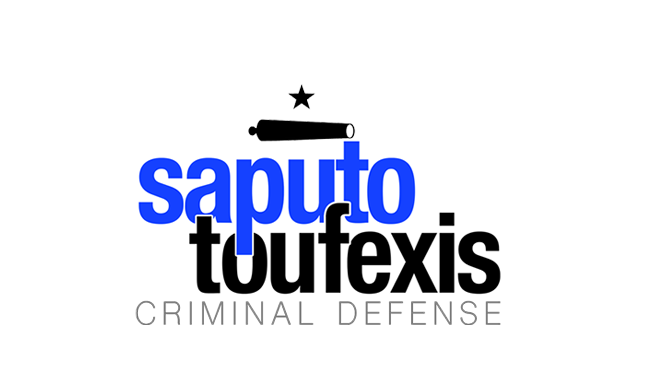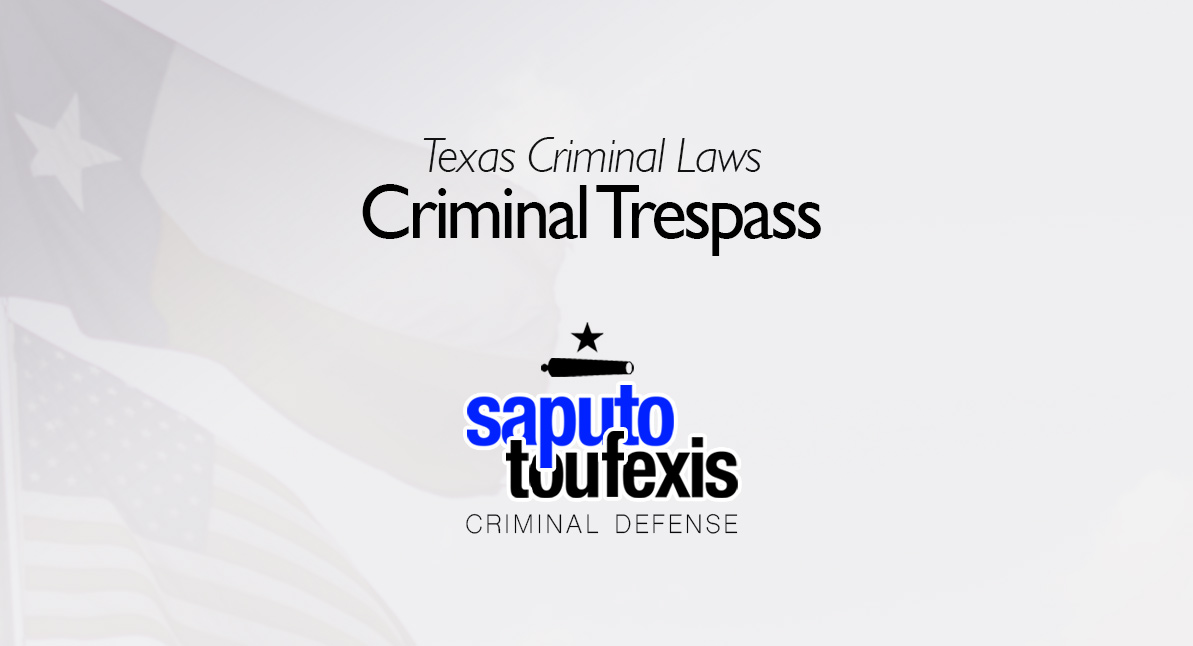The Texas Criminal Trespass law makes it a misdemeanor crime in Texas to enter or remain on or in someone else’s property if you were on notice that you were not supposed to be there.
FAQs about the
Criminal Trespass law in Texas
- What is the current Texas law about Criminal Trespass?
- What does it mean to “enter” a property?
- What is effective consent? How do I know if I have proper notice?
- What are the defenses to prosecution?
- What is the required notice to prevent carrying firearms on a premise?
- How can I be charged with a Criminal Trespass offense in Texas?
- What is the statute of limitation for Criminal Trespass in Texas?
- What is the penalty for a Texas Criminal Trespass offense?
- Can you get probation for Criminal Trespass in Texas?
- What level of crime is Criminal Trespass in Texas?
For you to be convicted of Criminal Trespass in Texas, the law requires that you had notice that you were not supposed to be on the property. Sometimes, property owners issue this notice in the form of a criminal trespass warning. If you receive a criminal trespass warning, then you are on legal notice that you are not welcome on the property. However, there are numerous other ways to be put on notice that you are not legally allowed on a particular property.
Have you been charged with Criminal Trespass? Contact us today to discuss legal representation.
or Text or Call (888) 239-9305
The Texas legislature codified the Criminal Trespass criminal offense in Texas Penal Code Section 30.05. The law was most recently updated in 2023 when the legislature added a penalty classification for Criminal Trespass offenses committed in the course of committing Human Smuggling under Section 20.05(a)(2). But the legislature has actually made changes to this law in every legislative session since 2001. The Criminal Trespass law is remarkably detailed, and the statute is quite long. There are several defenses to prosecution as well as exceptions to the law’s application.
The Texas Criminal Trespass law also includes trespass by carrying a firearm if the property owner has properly posted a firearms notice that firearms are prohibited on the premises. However, this firearms notice does not apply to licensed handgun owners who carry concealed or in a holster, as explained in more detail in the affirmative defense section below.
The Penal Code classifies the Texas Criminal Trespass law under Title 7 “Offense Against Property,” Chapter 30 “Burglary And Criminal Trespass.” Learn more about the Texas offense of Criminal Trespass below.
What is the current Texas law about Criminal Trespass?
Texas law currently defines the offense of Criminal Trespass in Penal Code Section §30.05 as follows:[1]
(a) A person commits an offense if the person enters or remains on or in property of another, including residential land, agricultural land, a recreational vehicle park, a building, a general residential operation operating as a residential treatment center, or an aircraft or other vehicle, without effective consent and the person:
(1) had notice that the entry was forbidden; or
(2) received notice to depart but failed to do so.
One of the key issues in this law is the type of notice required under the law. But what exactly counts as notice?
What does it mean to “enter” a property?
The Texas Penal Code defines entry as the “intrusion of the entire body”. This means, in the state of Texas, that you must be completely on the property, or on or in a vehicle or building. For example, reaching into someone’s car with your arm is not sufficient for a charge of criminal trespass. Going inside a building, sitting inside a car, or jumping a fence onto the property of someone else would be considered an “entry” under the law.
What is effective consent? How do I know if I have proper notice?
Section 30.05 of the Texas Penal Code lists all the ways that notice can be given:[2]
- An oral or written communication from the owner or a person with the authority of the owner. This means that if you have received a letter, telephone call, email, or have been verbally told by the owner that you are not allowed on the property that you have been given proper notice.
- Fencing or other enclosure that is clearly designed to keep people out or livestock in. Security fences or barbed wire might be examples of fencing obviously designed to keep people out.
- Signs that are reasonably likely to be noticed that indicate that entry is forbidden. For example, no trespassing or keep out signs posted at regular intervals on a fence, or a no entry sign posted on a gate would fall under this category.
- Purple paint marks on trees that meet specific criteria. These occur mostly in large undeveloped properties in woodland areas.
- Visible crops that appear to be grown for consumption, or in the process of being harvested. For example, a farm without a fence but with rows of corn would be considered as having proper notice.
What are the defenses to prosecution?
There are numerous defenses available in the current version of the Texas Criminal Trespass law. Certain employees and agents have an affirmative defense when they acted within the scope of their duty. For instance, firefighters, emergency medical services personnel, employees of electric utilities, telecome workers, other utility workers, and people employed by or acting as agent for an entity that had, or that the person reasonably believed had, effective consent or authorization provided by law to enter the property.
There are several affirmative defenses available if the basis for the prosecution was that entry with a firearm or firearm ammunition was forbidden.[3] These affirmative defenses are generally available if you are carrying a firearm to and from a place where you live, where you’re staying, and your vehicle. In addition, it is a defense to prosecution under the Criminal Trespass law that the basis on which entry on the property or land or in the building was forbidden was that entry with a handgun was forbidden and the person was carrying a license to carry a handgun, and the handgun was carried in a concealed manner or in a holster.[4]
There’s another affirmative defense available if you entered a railroad switching yard or any part of a railroad switching yard and were at that time an employee or a representative of employees exercising a right under the Railway Labor Act.[5]
In addition, there are a few circumstances in which the Texas Criminal Trespass law simply does not apply. The law does not apply if you were a peace officer at the time of the offense and the basis on which entry on the property or land or in the building was forbidden was that entry with a handgun or other weapon was forbidden. [6]
What is the required notice to prevent carrying firearms on a premise?
A person may provide notice that firearms are prohibited on the property by posting a sign at each entrance to the property that includes language that is identical to or substantially similar to the following:[7]
Pursuant to Section 30.05, Penal Code (criminal trespass), a person may not enter this property with a firearm
The notice must be written in both English and Spanish, appear in contrasting colors with block letters at least one inch in height; and be displayed in a conspicuous manner clearly visible to the public.[8]
How can I be charged with a Criminal Trespass offense in Texas?
You can be charged with Criminal Trespass if a police officer sees you entering a property that you do not have permission to enter. Other times, a Criminal Trespass charge can arise from a complaint filed by the property owners themselves. You may be charged with the offense even if you were originally on the property with permission if that permission was revoked or has expired. There are several other ways to be charged under the Texas Criminal Trespass law as well.
What is the statute of limitation for Criminal Trespass in Texas?
As a misdemeanor, Criminal Trespass charges have a two-year limitations period.[9]
What is the penalty for a Texas Criminal Trespass offense?
Under the Texas Penal Code, Criminal Trespass is typically classified as a either a Class A, Class B, or Class C misdemeanor, depending on the circumstances. A 2023 amendment created one instance in which Criminal Trespass may be prosecuted as a third degree felony.
Under the current penalty scheme, Texas law classifies the Criminal Trespass offense as a Class B misdemeanor, unless one of the exceptions apply.[10] For instance, if the offense occurred on agricultural land and within 100 feet of the boundary of the land or on residential land and within 100 feet of a protected freshwater area, the classification drops to a Class C misdemeanor.[11]
In another circumstance, if the Criminal Trespass occurred in a habitation or a shelter center, a ‘critical infrastructure’ location (such as a power plant, water treatment plan, or train yard), or Superfund site, the offense is classified as a Class A misdemeanor.[12] Additionally, the Criminal Trespass law classifies offenses that occurred on or in property of an institution of higher education as a Class A misdemeanor when the offender was previously been convicted of a similar Criminal Trespass offense related to a higher education institution.[13] For the purposes of this enhancement, a prior conviction includes a deferred adjudication plea.[14]
There are two more ways in which the law classifies Criminal Trespass as a Class A misdemeanor. First, if the Criminal Trespass is committed while carrying a deadly weapon (which includes firearms or any weapon that is reasonably capable of causing death or injury).[15] Second, the penalty can be enhanced to a Class A misdemeanor if the offense is committed on the property of or within a general residential operation operating as a residential treatment center.[16]
There is a special class of Criminal Trespass offenses that apply to situations where the person enters the property, land, or building with a firearm or other weapon and the sole basis on which entry on the property or land or in the building was forbidden is that entry with a firearm or other weapon was forbidden. In these cases, the offense is punished as a Class C misdemeanor, except that the offense is a Class A misdemeanor if after entering the property, land, or building with the weapon, the person personally received notice that entry with a weapon was forbidden and subsequently failed to depart.[17]
Amendments effective in 2024
The legislature created a new penalty classification in a third special session in 2023. This amendment went into effect February 4, 2024.[18] Under this new amendment, Criminal Trespass is classified as a third degree felony when it was committed in the course of committing a Section 20.05(a)(2) Smuggling of Persons offense.[19]
Can you get probation for Criminal Trespass in Texas?
The Texas Code of Criminal Procedure allows both judges and juries to grant probation for Criminal Trespass, and judges are also allowed to accept deferred adjudication plea deals.[20]
Note, however, that judges may not grant community supervision after a conviction if (1) the defendant used or exhibited a deadly weapon during the commission of the felony or immediate flight thereafter and (2) the defendant used or exhibited the deadly weapon himself or was a party to the offense and knew that a deadly weapon would be used or exhibited.[21]
What level of crime is Criminal Trespass in Texas?
The Penal Code classifies the punishment for Criminal Trespass as a Class A, Class B or Class C misdemeanor, depending on the circumstances.
Learn more about the penalty range for this offense in the section above.
Legal References:
^1. Texas Penal Code §30.05. This law is current as of 2024.^2. Texas Penal Code §30.05(b)(2)^3. See Texas Penal Code §30.05(f-1), (f-2), (f-3), and (f-4)
(f-1) It is a defense to prosecution under this section that:
(1) the basis on which entry on the property was forbidden is that entry with a firearm or firearm ammunition was forbidden;
(2) the actor is:
(A) an owner of an apartment in a condominium regime governed by Chapter 81, Property Code;
(B) an owner of a condominium unit governed by Chapter 82, Property Code;
(C) a tenant or guest of an owner described by Paragraph (A) or (B); or
(D) a guest of a tenant of an owner described by Paragraph (A) or (B);
(3) the actor:
(A) carries or stores a firearm or firearm ammunition in the condominium apartment or unit owner’s apartment or unit;
(B) carries a firearm or firearm ammunition directly en route to or from the condominium apartment or unit owner’s apartment or unit;
(C) carries a firearm or firearm ammunition directly en route to or from the actor’s vehicle located in a parking area provided for residents or guests of the condominium property; or
(D) carries or stores a firearm or firearm ammunition in the actor’s vehicle located in a parking area provided for residents or guests of the condominium property; and
(4) the actor is not otherwise prohibited by law from possessing a firearm or firearm ammunition.
(f-2) It is a defense to prosecution under this section that:
(1) the basis on which entry on a leased premises governed by Chapter 92, Property Code, was forbidden is that entry with a firearm or firearm ammunition was forbidden;
(2) the actor is a tenant of the leased premises or the tenant’s guest;
(3) the actor:
(A) carries or stores a firearm or firearm ammunition in the tenant’s rental unit;
(B) carries a firearm or firearm ammunition directly en route to or from the tenant’s rental unit;
(C) carries a firearm or firearm ammunition directly en route to or from the actor’s vehicle located in a parking area provided for tenants or guests by the landlord of the leased premises; or
(D) carries or stores a firearm or firearm ammunition in the actor’s vehicle located in a parking area provided for tenants or guests by the landlord of the leased premises; and
(4) the actor is not otherwise prohibited by law from possessing a firearm or firearm ammunition.
(f-3) It is a defense to prosecution under this section that:
(1) the basis on which entry on a leased premises governed by Chapter 94, Property Code, was forbidden is that entry with a firearm or firearm ammunition was forbidden;
(2) the actor is a tenant of a manufactured home lot or the tenant’s guest;
(3) the actor:
(A) carries or stores a firearm or firearm ammunition in the tenant’s manufactured home;
(B) carries a firearm or firearm ammunition directly en route to or from the tenant’s manufactured home;
(C) carries a firearm or firearm ammunition directly en route to or from the actor’s vehicle located in a parking area provided for tenants or tenants’ guests by the landlord of the leased premises; or
(D) carries or stores a firearm or firearm ammunition in the actor’s vehicle located in a parking area provided for tenants or tenants’ guests by the landlord of the leased premises; and
(4) the actor is not otherwise prohibited by law from possessing a firearm or firearm ammunition.
^4. Texas Penal Code §30.05(f)^5. Texas Penal Code §30.05(g)^6. See Texas Penal Code §30.05(i)^7. Texas Penal Code §30.05(c)^8. Texas Penal Code §30.05(c)(2),(c)(3) and (c)(4)^9. See Code of Criminal Procedure 12.02(a)^10. Texas Penal Code §30.05(d)(1)^11. Texas Penal Code §30.05(d)(2)^12 Texas Penal Code §30.05(d)(3)(A)^13. Texas Penal Code §30.05(d)(3)(B) as enacted by Senate Bill 1649, 85th Texas Legislature, Sections 3-4, effective September 1, 2017. Pursuant to Section 30.05(d)(3)(B), the offense is punishable as a Class A misdemeanor if:
(B) the offense is committed on or in property of an institution of higher education and it is shown on the trial of the offense that the person has previously been convicted of:
(i) an offense under this section relating to entering or remaining on or in property of an institution of higher education; or
(ii) an offense under Section 51.204(b)(1), Education Code, relating to trespassing on the grounds of an institution of higher education;
However, according to subsection (d-2): “At the punishment stage of a trial in which the attorney representing the state seeks the increase in punishment provided by Subsection (d)(3)(B), the defendant may raise the issue as to whether, at the time of the instant offense or the previous offense, the defendant was engaging in speech or expressive conduct protected by the First Amendment to the United States Constitution or Section 8, Article I, Texas Constitution. If the defendant proves the issue in the affirmative by a preponderance of the evidence, the increase in punishment provided by Subsection (d)(3)(B) does not apply.”^14. Texas Penal Code §30.05(d-1), as enacted by Senate Bill 1649, 85th Texas Legislature, Section 2, effective September 1, 2017^15. Texas Penal Code §30.05(d)(3)(C)^16. Texas Penal Code §30.05(d)(3)(D)^17. Texas Penal Code §30.05(d-3)^18. SB 4, 88th Texas Legislature (SS3), Section 12 & 13^19. Texas Penal Code §30.05(d)(4), as enacted by SB 4, 88th Texas Legislature (SS3), Section 10^20. See Chapter 42, Texas Code of Criminal Procedure, Art. 42A.054, Art. 42A.056, Art. 42A.102^21. Art. 42A.054(b), Texas Code of Criminal Procedure










